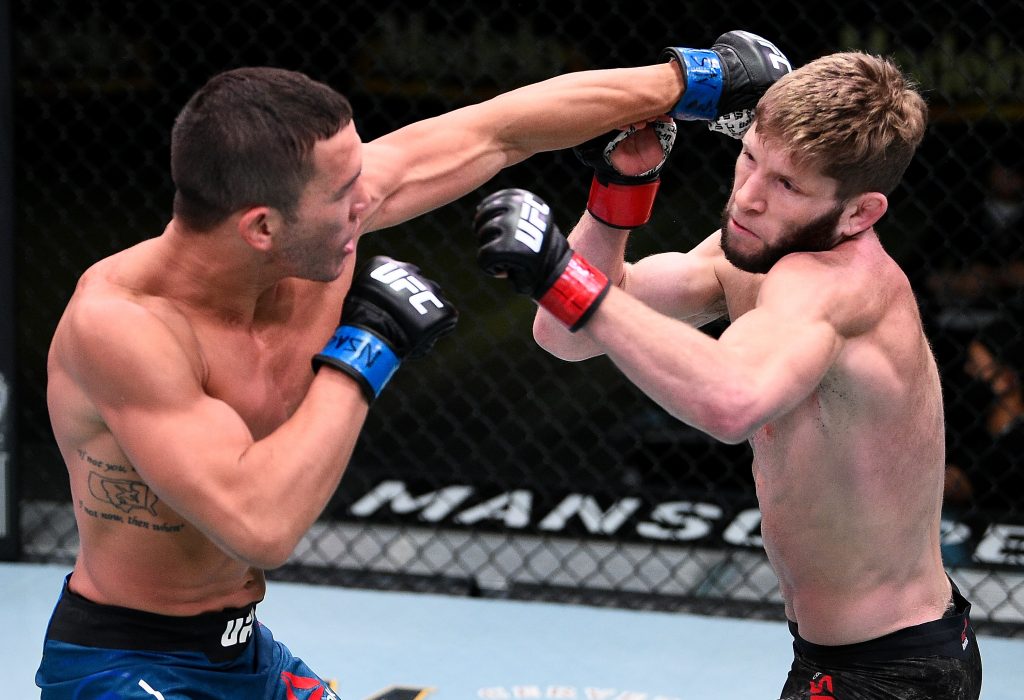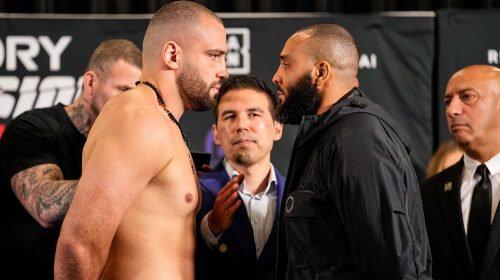
UFC on ESPN+ 34: Overeem vs. Sakai judging breakdown
The 10-8 round in mixed martial arts is becoming more standardized before our eyes at UFC Apex.
Not that judges hadn’t already been empowered by the August 2016 revisions to the mixed martial arts scoring criteria, mind you. We’ve seen more consistency in the application of 10-8s since then, compared to previous years. But even at that, judges are still working behind the scenes to calibrate when they should and shouldn’t put down the 10-8. I imagine that’s about as easy as you and your friends all trying to coordinate the same exact picture settings on your respective TV, except doing so without being in the same room and not being able to see the numbers for the contrast and brightness levels. Good luck with that.
And yet, Saturday night’s snakebitten UFC on ESPN+ 34 card, which only produced 13 scored rounds in total out of seven bouts, gave us the fifth unanimous 10-8 from the judges in the past four UFC events. Only two other rounds merited at least 10-8 in that time out of 68 total scored rounds. That puts the rate of unanimous 10-8s at 7.4% over that span, and 10.3% for rounds that garnered at least one 10-8 from the judges. Seeing how Alistair Overeem’s big round 4 performance, just before finishing what he started against Augusto Sakai 26 seconds into the final frame, was the lone 10-8 out of 13 rounds Saturday, that unanimous 10-8 rate held steady at 7.7%.
As for that round itself, it shouldn’t be a surprise why Derek Cleary, Sal D’Amato and Junichiro Kamijo all agreed The Reem earned that dominant round score. Take note, however, that this wasn’t an Overeem round from bell to bell or something along those lines. The first half of the round consisted of the same tactical skirmishes we’d seen for most of the first 15 minutes. A big standing elbow against the cage from Sakai even opened a sizable cut on the Dutchman’s forehead, the blood trickling down his nose.
But with 2:15 to go in the frame, not long after a break in the action for a low blow to Sakai, Overeem dumps the Brazilian with a single-leg, and the narrative begins to change. After a minute of solid but intermittent ground strikes, Overeem finally connects on a short but heavy left while postured up to put Sakai in real trouble. The follow-up damage from the 40-year-old came steadily and severely until the horn, as Sakai did little but survive the remaining minute.
Right there, in that minute-plus, Overeem arguably checked off all three Ds the criteria calls for — impact (a.k.a. damage), dominance and duration — to get that 10-8. Sakai clearly was compromised by the brutal ground shots raining down from the former Strikeforce heavyweight champion. The 29-year-old couldn’t muster any defense or counter either, giving you the dominance the criteria seeks. And the fact that Overeem put the hurting on Sakai for that full minute, completely unanswered, goes toward the argument for the third D: duration. That last one may be the most debatable, as we’ve seen fighters pour on the ground-and-pound at a higher rate than that. Even so, a judge should consider a 10-8 if only two Ds are checked off. Whatever the case may be, all three veteran officials saw it the same way.
The other 12 completed rounds made for a pretty standard night of judging from the elite group of judges the Nevada State Athletic Commission recruited for this one. There were 3 split rounds:
- Overeem vs. Sakai, round 2 (only Cleary had Overeem)
- Ovince Saint Preux vs. Alonzo Menifield, round 1 (only Ron McCarthy had Menifield)
- Viviane Araujo vs. Montana De La Rosa, round 3 (only Cleary had De La Rosa)
Seemed as though most of MMA Twitter on Saturday night saw several close rounds in Overeem-Sakai before the fourth, so most wouldn’t be too mad with a split there. Same for OSP-Menifield, which was marked by low output and strikes landed numbers that were pretty even — usually a recipe for understandable disagreement among the officials — before Saint Preux starched the prospect in the second round.
As for Araujo-De La Rosa, judges Ron McCarthy and Rick Winter likely favored the impact of Araujo’s landed strikes over the volume edge from De La Rosa. Most media scores submitted to MMA Decisions for this one agreed with McCarthy and Winter assessing 30-27, with only one of 16 media scores agreeing with Cleary’s card. That’s not a measuring stick for whether 10-9 De La Rosa in the third is a good or bad score. Anecdotally, most MMA media members haven’t read the scoring criteria or spoken with officials to better understand it. But it does back the majority score from the working judges. Cleary could have sided with De La Rosa in a close for a number of reasons, such as an unfavorable angle or plain old subjectivity in interpreting how the actions of each woman affected the other. Hey, at least it was the third round in a fight De La Rosa realistically needed to finish in order to win. No harm done.
Otherwise, a smooth night from the judges in Nevada, which has been the norm more often than not at UFC Apex. Heck, Anthony Maness flew in from out of state for the second time in three weeks and didn’t even turn in a round score for his only assignment: Brian Kelleher’s 39-second submission of late replacement Ray Rodriguez. Light work, indeed.
Here’s a breakdown of the number of rounds, fight assignments, and individual round dissents from the majority per judge, noting that dissents aren’t necessarily right or wrong:
- Mike Bell: 4 rounds, 2 assignments, 0 dissents
- Cleary: 7 rounds, 3 assignments, 2 dissents
- Eric Colon: 5 rounds, 2 assignments, 0 dissents
- Sal D’Amato: 6 rounds, 4 assignments, 0 dissents
- Dave Hagen: 4 rounds, 2 assignments, 0 dissents
- Kamijo: 6 rounds, 3 assignments, 0 dissents
- Maness: 0 rounds, 1 assignment
- McCarthy: 4 rounds, 3 assignments, 1 dissent
- Winter: 3 rounds, 1 assignment, 0 dissents

























